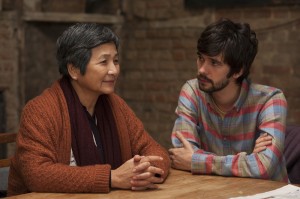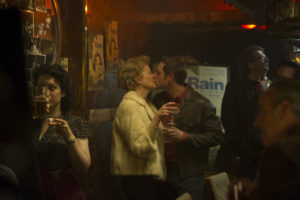
I want to dispense with the plot details up front: Aaron (Patrick Brice) is answering a Craigslist ad that offers to pay a cameraman for a day of filming, thereby setting up the found footage style. He finds Josef (Mark Duplass) at a remote cabin, and Josef tells Aaron that he has terminal cancer and wants to record a video of himself for his unborn son to watch after he dies. At first, Josef simply seems like an odd man with a sweet request for his new acquaintance, but as might be expected from the trailer, poster, title, or genre, things go awry, many of those things being unexpected and that I don’t want to spoil here. That’s really not the important stuff though, and that’s why I want to get rid of it so quickly. What makes Creep one of the best, most fascinating and entertaining films of the year isn’t the story (as solid and interesting as it is); it’s the acting, the mood, the dialogue, the technique, the pacing, the props (serious high fives are due to whoever stumbled upon the Peachfuzz wolf mask) that really make it shine. The fact that it’s both a hilarious comedy and a distressing, truly frightening horror film is evidence itself of Brice’s skill as a director and adeptness at tension and release.
The comedy comes from two places. One, there’s Brice and Duplass’ twisted Abbot and Costello routine, Brice a game and delightful straight man to Duplass’ twisted image, a man whose face morphs and contorts, masked literally and figuratively to hide his own gurgling, bubbling, boiling evil underneath. An early scene where Aaron films Josef having bathtub time with an imaginary baby is both hilariously uncomfortable and genuinely distressing precisely because of the uncanny valley of human emotion, not coincidentally twisting his eyebrows into devilish peaks like old rubber-face Jim Carrey while he imitates a loving father. Duplass is completely in control while still flying off the handle into uninhibited and unhinged manipulative glee and rage. He absolutely owns the role, flooring the audience with some good old-fashioned scenery chewing (which I mean in an entirely positive way). This is to say nothing of Brice’s subtle, affecting work as Aaron, making us believe him through all the movie logic twists and turns so that it feels real, and really unsettling — until the roof comes off and the walls fall down and the camera pulls back to show the artificiality of such tropes, displacing the audience in an entirely different way.
This is precisely where the second angle of Creep‘s comedy comes in, which is its incisive and smart commentary on the horror film genre, pushing certain things towards such a point of absurdity that their very breaking of the suspension of disbelief makes them resonate. The ending especially (no spoilers, I promise) is pushed to such a degree that it plays as a ridiculous and hysterical application of the rake joke, a simple idea stretched so long and made so many times that it starts funny, becomes tedious, and goes back around to being funny from sheer repetition (see: every Mike Meyers film out there). Then, the movie has the brass balls to hang a lantern on its own joke, which instead of being grating makes it all the more endearing.
Here we find a wonderful argument for the acceptance of found footage as not just a genre sub-heading, but a style in its own right, a decision that can be made to emphasize and clarify the themes of a film. People act like found footage is a fad that will pass in time, but this is ignorant to the history of genre film in general; no trope of horror cinema ever truly dies. Giallo was supposed to be a fad until it became intrinsic to the language of movies; slasher films were a teen trend until we kept making them 30+ years after their predicted death; exploitation films should’ve died when grindhouse theaters went away, but of course a new generation of filmmakers influenced by their no-budget aesthetics and pulpy entertainment made new ones, made to look like the old ones. It never goes away. Found footage is just another tool in the box, one to be pulled out when needed, and Brice and Duplass know that; they use found footage to create intimacy and subjective experience while also playing against the “realism” of such films with blatant unreality.
This is to say that the horror comes from the same places as the comedy outlined above, and the handheld, pseudo-documentary style gives it a different set of wings from horror-comedy of the past. If you looked down its family tree, somewhere would be the British version of The Office, that great wellspring of discomfort comedy that was — shocker — also presented in a documentary style. Without this style, the comedy would be stilted and weird instead of naturally awkward and the horror would fall on its face. In a movie where the camera serves as an objective presence (which, beyond intense stylization, is mostly the case in non-found footage cinema), the Peachfuzz mask would look as silly as it really is instead of being hilariously grotesque and ugly. In the film’s most genuinely disturbing and horrifying scenes, there isn’t even any visual accompaniment, just a simple description of the origins of Peachfuzz the wolf. And that mask — not to put too fine a point on it, but its transformative powers are truly impressive, and would be overused in a movie with less of a sure hand. Here, it’s exactly as it needs to be in the camera’s eye, a symbol of a man gone feral, given just enough gravity to make you laugh in nervous tension, the way you laugh after being scared in a haunted house.
Creep excels at dredging up those sorts of emotions, simultaneously revulsion and fascination, sympathy and distrust, incredulity and belief. It plays its two leads and two tones against each other to create sparks, and they come early and often but twist into new, unexpected forms as the film evolves and moves forward. Not content to be either a parody or the genuine article, it becomes both with fearless dedication, focusing in on its central terror by broadening that center’s ways of movement and execution. As a found footage devotee myself, I found it not only one of the best examples of the style in recent memory, but one of the smartest and most knowing, completely understanding why it’s using the form and not just throwing it in as a way to decrease budget and increase jump scares. All that, and it knows how to get in and out under 90 minutes! Restraint and excess living in harmony. What a wonderful world to be terrorized by a man in a wolf mask in.
—
Creep is available streaming on Netflix and for video on demand on iTunes.
Directed by Patrick Brice; written by Patrick Brice and Mark Duplass; starring Patrick brice and Mark Duplass; 82 minutes.



 Derek
Derek
 Isabelle
Isabelle